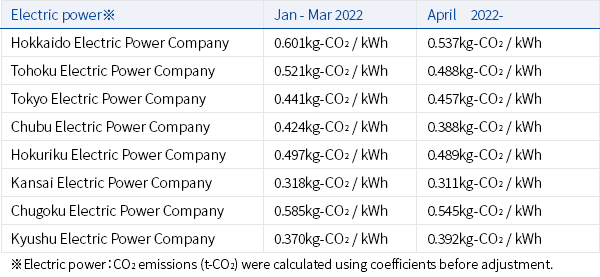Calculation Standard
| Environmental performance index | Unit | Calculation method | |
|---|---|---|---|
| INPUT | Total energy input amount | GJ | Energy amount consumed in business activities (GJ) Σ[Each energy annual use amount x each unit calorific value]×10-3 *Source: Energy supply and demand results in 2020 (final) (published on April 21, 2023) Resources and Energy Agency |
| January 2022 — | |||
| Electricity: 3.6 MJ / kWh | |||
| Bunker A: 38.9 MJ / L | |||
| Kerosene: 36.5 MJ / L | |||
| Light Oil: 38.0 MJ / L | |||
| LPG: 50.1 MJ / kg | |||
| City Gas: 39.9 MJ / m3 | |||
| Gasoline: 33.4 MJ / L | |||
| LNG: 54.7 MJ / kg | |||
| GJ | Amount of cold and hot water, the heat source, accepted from local cooling and heating system for ventilation use at the headquarters (Makuhari headquarters until FY2022) | ||
| Raw materials input amount | t | Annual use of raw materials directly used for manufacturing of products (t) | |
| Use amount of water | m3 | Annual use of clean water and underground water (m3) | |
| Environmental performance index | Unit | Calculation method | ||
|---|---|---|---|---|
| OUTPUT | Carbon dioxide (CO₂) emission amounts | Business activities | t | CO₂ emitted from the energy used in business activities (t) *List of calculation method and emission coefficients in the calculation, report and publication system under the Law to Promote Global Warming Countermeasures |
 |
||||
| January 2022 — | ||||
| Bunker A: 2.71 kg-CO₂ / L | ||||
| Kerosene: 2.49 kg-CO₂ / L | ||||
| Light Oil: 2.58 kg-CO₂ / L | ||||
| LPG: 3.00 kg-CO₂ / kg | ||||
| City Gas: Tokyo Gas: 2.21 kg-CO₂ / m3 Osaka Gas: 2.29 kg-CO₂ / m3 Kita Gas: 2.29 kg-CO₂ / m3 Suwa Gas: 2.29 kg-CO₂ / m3 |
||||
| Cold/Hot Water: 0.057 kg-CO₂ / MJ | ||||
| Gasoline: 2.32 kg-CO₂ / L | ||||
| LNG: 2.70 kg-CO₂ / kg | ||||
| ※1:Electricity consumption x Emissions per unit consumption | ||||
| ※2:(For each fuel type) Fuel consumption x Heat value per unit usage x Carbon emission per unit heat value x 44/12 | ||||
| ※3:(For each type of heat) Heat consumption x Emissions per unit usage | ||||
| Dust amount (t)=dust density (g/m3N) × dry exhaust gas amount per unit hour (m3N/h) × annual operation hours (h/year) × 10-6 | ||||
| Sox (t) = sulfur oxide density (ppm) × dry exhaust gas amount per unit hour (m3N/h)× annual operation hours (h/year) × 64/22.4× 10-9 | ||||
| NOx (t)=nitrogen oxide density (ppm)×dry exhaust gas amount per unit hour (m3N/h)× annual operation hours (h/year) × 46/22.4 × 10-9 | ||||
| Logistics | t | Carbon dioxide emitted by energy consumed in logistics | ||
| [Light oil annual consumption × CO₂ emission coefficient] × 10-3 | ||||
| Fuel efficiency | ||||
| 10-ton car: 4 km / L | ||||
| 4-ton car: 5 km / L | ||||
| 2-ton car: 6 km / L | ||||
| Shipping weight: Annual shipment volume | ||||
| Set distance: (scheduled delivery) measured distance | ||||
| (Consolidated delivery) Distance from the office to prefectural capitals | ||||
| Transport distance: (shipment weight / maximum loading weight) x set distance | ||||
| Fuel consumption: transport distance / fuel efficiency | ||||
| January 2022 — | ||||
| CO₂ emission coefficient Light Oil: 2.58kg-CO₂ / L | ||||
| Amount of chemical emissions and transfers | kg | Emissions and transfers (kg) of designated chemical substances at business establishments that have been required to submit notifications based on the Ordinance for Enforcement of the Act on Confirmation of Release Amounts of Specific Chemical Substances in the Environment and Promotion of Improvements to the Management Thereof (PRTR System) | ||
| Amount of waste emissions | t | Final disposal amount: Outsourced waste amount (t) x Final disposal rate (%) [Final disposal rate] ・General waste: 8.7% (quoted from the Ministry of the Environment on the status of general waste emissions and treatment (FY 2021 results)) ・Industrial waste: Values obtained from waste treatment companies |
||
Contact us
For inquiries about product technology, product purchases,
catalogs, and quality
